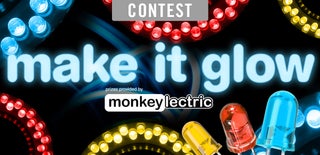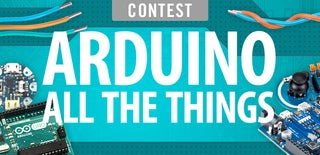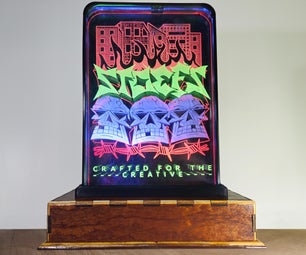Introduction: Beambox: NEXT - the Tower That Glows to Your Commands
Beambox NEXT is the second version of the cheap, easy to build light tower.
It runs off of an Arduino Nano and costs less than $15. What's new is this version is the redesigned base, accompanied by 3 capacitive touch buttons and a much heavier wooden base making it less prone to falling over.
The Beambox: NEXT has many effect presets that you can chose from using the capacitive touch button, this means you can use the Beambox: NEXT without a computer. The presets are customisable, with some including:
- Rainbow cycle
- Fade in-out of any colors
- Twinkle effect in any color
- Just colors
All of these effects are customization in the thousands of colors to choose from.
There is even an option to control the beambox with your computer using the light sequencing program, Vixenlights! (not my program)
Don't like to code? No problem! All the code is provided for you so you can have fun choosing the right colors instead of choosing the right syntax to program it with.
If you have read this far that means that you are interested in the Beambox Next. Be sure to vote so I can level up my equipment to make even better instructables!

Step 1: What's in the Package?
This is an explanation step, skip over it to get straight to the building steps!
The Beambox NEXT light tower with 6/7 individually addressable LED's (WS2811) which are controlled by an Arduino Nano.
The Arduino can take inputs from a computer or from any of the 3 capacitive touch buttons located on the back of the base.

Lighting effects on the beambox can include:
- Solid Colors
- Fading Colors
- Rainbow Fade/Cycle
- Candle/Flicker
- & many more

Step 2: Materials
- Corflute (or corrugated plastic)Bunnings Warehouse | Home Depot
- Wooden Block (I cut a square piece from an off cut of scrap wood)
- Arduino Nano (also known as the Arduino Micro) Adafruit | eBay AU | eBay US | Amazon
- WS2811 LED Strip/String (a strip is better) Adafruit | eBay AU | eBay US | Amazon
- USB cable for Arduino (this may vary)
- Wires
- Screws (for the capacitive touch buttons)
- 3x 1M ohm resistors
Step 3: Base Construction
After completing this step, you should have the base complete with the 3 capacitive touch buttons (in the form of screws).
To get there, first you have to cut the slots that will hold the front and the back of the corflute tower. To do this, you need to just cut 2 slots (about 150mm deep & 2-3mm wide) into the square piece of wood and then check to see if the corflute fits into it nicely. You may need to flatten the corflute a bit but it should be able to fit.
Now, you need to choose the positions of the three screws that will become the capacitive touch buttons. After you have chosen the position, then you need to drill a particularly long guiding hole for the screw - this should be longer than the actual screw.
Then you need to drill another hole directly above that hole that you drilled, but on the top of the wooden block. The photo's explain this better.
This hole will need to be drilled down into the other hole you drilled going horizontally.
Here you have to strip off a substantial amount of insulation off 3 wires - the exposed ends then need to be pushed into the holes from the top. While holding those wires in the top - it is needed then to drill the screw in so that it grab the exposed wires - thus making a connection between the wires on top and the screws facing the outside of the wooden base.
Here is a gif to show this better.
If you also noticed in the pictures, I drilled an trench for the middle button's wire to guide it under the Arduino Nano to allow it to sit flat.
Step 4: Tower Construction
Phew, so the base is done - now all that's left on the construction side of things is the tower and the connection between them.
The tower comprises of 3 parts:
- 2 long corflute strips
- 2 slightly shorter corflute strips
- The LED strip (or string)
So first, we will begin with cutting the corflute strips.
I wanted the Beambox to be around 45cm but these strips can be whatever size you want.
To account for the inset tabs that hold the beambox onto the base, I (of course) didn't plan it and calculate the measurements - so I rather just inserted some corflute in and marked the height from the button of the base.
Then for the 2 shorter strips, it is as easy as just making them the length that you want the whole tower to be.
After that, grab one of the two longer corflute strips and put it in the base as if you were making the actual thing. Next, align the Arduino Nano against it - this will give you a guide on the hole that you need to cut for the USB cable to go through and connect to the Arduino. After you have measured it then it needs to be cut out using for example, a hobby knife.
Step 5: Tower Construction (p.t. 2)
Gather the LED's as now we will be attaching them to the untouched long strip of corflute we made. There are now two paths to take depending if you are using:
1. An LED strip (like this one here)
For an LED strip, you just need to peel the backing off it and possibly add a little bit of hot glue.
or
2. An LED string (for example, this one)
So now grab the hot glue gun, and next you should glue a long strip onto a short strip. Do this twice so that you have 2 glued pieces. Then after that, just glue those two together so that it forms a tall box (as seen in the photos).
It's not done yet though!
For the finale - grab a small piece of corflute and cut out a square to "top it all off" (with a top for the Beambox)
Step 6: Soldering
This is an easy step because soldering really isn't that hard.
Just grab your soldering iron and make these connections - be sure to put the connectors where it tells you to.
Follow the schematic included below. There is also a color key below the picture to show you what the colors mean if you are unsure.

COLOR KEY
Yellow - Arduino D9 to the LED strip
Red - Arduino +5v to LED strip +5v
Grey - Arduino GND to LED strip's GND
Black - Arduino GND to 1 side of all the 1M ohm resistors
Magenta - Arduino Data 4 to Touch Button 3
Light Blue - Arduino Data 5 to Touch Button 2
Light Green - Arduino Data 8 to Touch Button 1
Step 7: Code
Make sure to have Adafruit's Neopixel library installed when uploading. It is available here and or on the library manager.
You also need a library call CapacitiveSensor - it is available from Arduino.cc Playground here. The page also includes lots of information on the theories behind capacitive sensing if that is what you are into.
After those two libraries are installed - fire up the custom code available here:
If you are going to want to be controlling the Beambox NEXT by itself with the capacitive buttons:
Use this code: MIRROR 1 | MIRROR 2
If you are going to be controlling the Beambox using the light sequencing software, VIXENLIGHTS:

Participated in the
Make It Glow! Contest

Participated in the
Arduino All The Things! Contest

Participated in the
Leftovers Challenge













